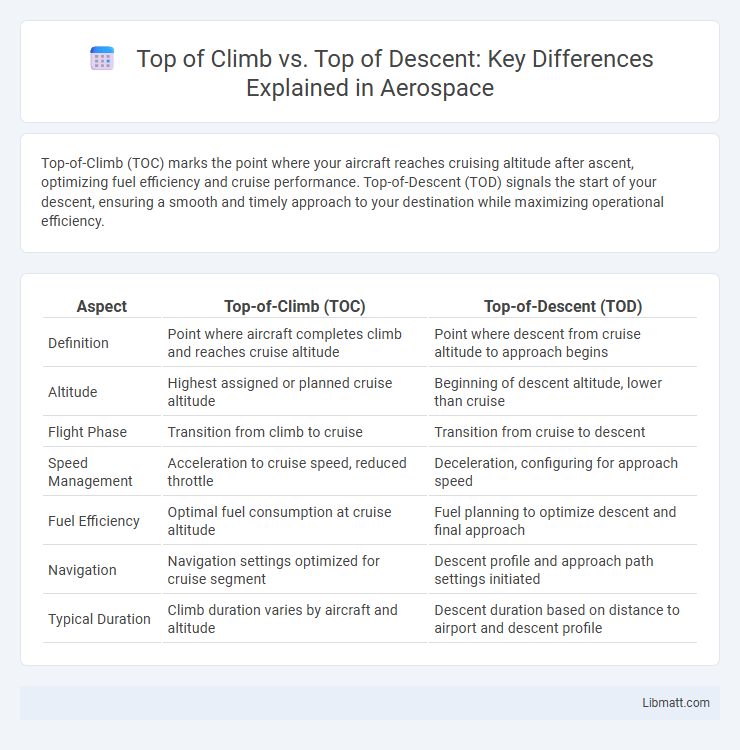Top-of-Climb (TOC) marks the point where your aircraft reaches cruising altitude after ascent, optimizing fuel efficiency and cruise performance. Top-of-Descent (TOD) signals the start of your descent, ensuring a smooth and timely approach to your destination while maximizing operational efficiency.
Table of Comparison
| Aspect | Top-of-Climb (TOC) | Top-of-Descent (TOD) |
|---|---|---|
| Definition | Point where aircraft completes climb and reaches cruise altitude | Point where descent from cruise altitude to approach begins |
| Altitude | Highest assigned or planned cruise altitude | Beginning of descent altitude, lower than cruise |
| Flight Phase | Transition from climb to cruise | Transition from cruise to descent |
| Speed Management | Acceleration to cruise speed, reduced throttle | Deceleration, configuring for approach speed |
| Fuel Efficiency | Optimal fuel consumption at cruise altitude | Fuel planning to optimize descent and final approach |
| Navigation | Navigation settings optimized for cruise segment | Descent profile and approach path settings initiated |
| Typical Duration | Climb duration varies by aircraft and altitude | Descent duration based on distance to airport and descent profile |
Introduction to Top-of-Climb (TOC) and Top-of-Descent (TOD)
Top-of-Climb (TOC) marks the point where your aircraft transitions from the climb phase to cruising altitude, enabling optimized fuel efficiency and flight performance. Top-of-Descent (TOD) signifies the calculated point to begin descending toward the destination airport, ensuring precision in approach and landing timing. Understanding TOC and TOD enhances flight planning accuracy and overall operational safety.
Definition and Significance of TOC and TOD
Top-of-Climb (TOC) marks the point where an aircraft completes its ascent and reaches cruising altitude, while Top-of-Descent (TOD) indicates when the descent toward the destination airport begins. TOC is significant for optimizing fuel efficiency and maintaining a stable cruise phase, whereas TOD ensures precise descent planning for a safe and timely arrival. Understanding TOC and TOD helps you manage flight phases effectively, improving overall flight performance and passenger comfort.
Navigational Technology in Determining TOC and TOD
Modern navigational technology plays a crucial role in accurately determining the Top-of-Climb (TOC) and Top-of-Descent (TOD) points during flight planning and execution. Advanced Flight Management Systems (FMS) integrate GPS data, aircraft performance metrics, and real-time atmospheric conditions to optimize TOC and TOD calculations, ensuring efficient fuel consumption and adherence to air traffic control constraints. Your flight's navigation accuracy and overall efficiency significantly benefit from these technologies, enhancing safety and operational precision.
Key Differences Between TOC and TOD
Top-of-Climb (TOC) marks the point where an aircraft completes its ascent and reaches cruising altitude, while Top-of-Descent (TOD) indicates the start of the descent phase toward the destination. TOC is crucial for fuel efficiency and optimal cruising performance, whereas TOD is essential for ensuring a smooth and safe approach by managing descent rate and speed. Understanding the key differences between TOC and TOD helps you optimize flight planning and enhance overall flight safety.
Impact on Flight Planning and Fuel Efficiency
Top-of-Climb (TOC) and Top-of-Descent (TOD) significantly influence flight planning and fuel efficiency by determining optimal cruising altitude segments and descent profiles. Accurate identification of TOC maximizes fuel savings through efficient climb performance, while precise TOD calculations enable smooth descents that reduce idle fuel burn and minimize holding patterns. You can optimize overall flight cost and environmental impact by integrating TOC and TOD data into advanced flight management systems.
Pilots’ Procedures at TOC vs TOD
Pilots at Top-of-Climb (TOC) focus on optimizing cruise altitude, verifying aircraft performance, and setting navigation systems for the en-route phase, ensuring fuel efficiency and compliance with flight plans. At Top-of-Descent (TOD), procedures shift to calculating descent profiles, briefing approach charts, and configuring aircraft systems for a smooth transition to the approach phase. Your attention at each point ensures precise altitude changes and adherence to air traffic control instructions, maintaining safety and efficiency throughout the flight.
Role of Air Traffic Control During Climb and Descent
Air Traffic Control plays a pivotal role during both Top-of-Climb (TOC) and Top-of-Descent (TOD) phases by providing precise altitude clearances and route adjustments to maintain safe separation and optimize traffic flow. During TOC, controllers coordinate climbs to cruising altitude ensuring aircraft ascend efficiently while avoiding conflicts with other traffic or weather. At TOD, controllers manage descent paths and spacing, facilitating smooth transitions to approach sequences and helping pilots comply with airspace restrictions and runway availability.
Common Errors and Safety Considerations
Common errors at Top-of-Climb (TOC) and Top-of-Descent (TOD) include misjudging altitude or distance, leading to premature or delayed transitions that compromise flight efficiency and safety. Confusing TOC and TOD waypoints can result in incorrect thrust settings or descent profiles, increasing fuel consumption or risk of altitude deviations. Your situational awareness and adherence to precise navigation data are critical to avoid these errors and ensure safe altitude changes during flight phases.
Advanced Aircraft Systems and Automation
Top-of-Climb (TOC) and Top-of-Descent (TOD) are critical phases managed by advanced aircraft systems to optimize flight efficiency and safety. Modern flight management systems (FMS) use real-time data and automation to precisely calculate TOC and TOD points, ensuring optimal fuel consumption and adherence to air traffic control constraints. Your aircraft's automation aids in reducing pilot workload by seamlessly transitioning between climb, cruise, and descent, enhancing overall situational awareness and operational performance.
Future Trends in Flight Profile Optimization
Future trends in flight profile optimization emphasize precise integration of Top-of-Climb (TOC) and Top-of-Descent (TOD) calculations to enhance fuel efficiency and reduce emissions. Advanced algorithms leverage real-time data from aircraft systems and air traffic control to adjust TOC and TOD dynamically, optimizing climb and descent paths. Your flight management system will increasingly utilize predictive analytics to synchronize TOC and TOD with atmospheric conditions and airspace constraints, driving improvements in operational efficiency.
Top-of-Climb vs Top-of-Descent Infographic

 libmatt.com
libmatt.com